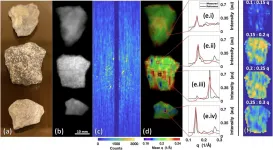(Press-News.org) [RALEIGH, N.C.] - How are the squirrels doing this year? The bears? The armadillos? How would you know? A new paper published June 8 sets up the framework for answering these questions across the United States by releasing the data from the first national mammal survey made up of 1,509 motion-activated camera traps from 110 sites located across all 50 states.
Unlike birds, which have multiple large-scale monitoring programs, there has been no standard way to monitor mammal populations at a national scale. To address this challenge, scientists from the North Carolina Museum of Natural Sciences and the Smithsonian Conservation Biology Institute recently collaborated with more than 150 scientists on the first-ever nationwide wildlife survey, called Snapshot USA. "Our goal was to provide a space for researchers from all 50 states to contribute a subset of their data to a broader initiative to maximize our coverage of the country and better understand drivers of mammal distributions to best inform conservation as rapidly as possible," said the Museum's Curator of Mammalogy Michael Cove, lead author of the new paper.
For two months in fall 2019 researchers collected more than 166,000 images of 83 different mammal species. White-tailed deer were the most common species detected (34,000+ times at 1,033 sites), followed by eastern gray squirrels and raccoons. Pygmy rabbits, mountain beavers, hog-nosed skunks and marsh rabbits were among the least common mammals photographed. Yet, the overall detection winner was the coyote, which was detected in all 49 continental states -- they have not made it to Hawaii yet. All the data are archived at the Smithsonian Institution's eMammal database and published as part of the new paper.
In an interesting twist, developed areas tended to have the highest overall mammal detections, with three of the top five sites for total mammal activity being urban -- Urbana, IL.; Baltimore, MD.; and Washington, D.C. "These new data show that the urban mammal paradox, with more animals actually living close to people, is not just an isolated phenomenon," said coauthor Roland Kays, a scientist at the museum and at NC State University.
When comparing particular species across the country, North Carolina stood out for being in the "Top 10" for the relative abundance of black bears (#3 Dare County, #4 Craven County, #7 Pender County, #8 Haywood County); bobcats (#5 Dare County); coyotes (#8 Haywood County); white-tailed deer (#5 Surrey County, #9 Alamance County, #10 Moore County); and turkeys (#8 Craven County, #9 Burke County and #10 Moore County). Nationally, ranking of top sites for select mammal species can be found at https://public.tableau.com/app/profile/roland.kays/viz/SS_USA_rankings/Dashboard1.
The research results appeared June 8 in Ecology, a publication of the Ecological Society of America, the nation's largest organization of professional ecologists. The publication makes the 2019 survey data available online for anyone to use for research questions, such as the evaluation of changes in animal populations over time or informing conservation strategies for threatened and endangered species. "This project involved a remarkable level of cooperation and data sharing that will have to be the standard going forward to adequately monitor our valuable wildlife resources at the national scale," adds William McShea of the Smithsonian Conservation Biology Institute.
The scientists repeated the survey in fall 2020 likely providing insights on the effects of the COVID-19 pandemic on wildlife distributions and habitat use -- resulting data will be available as the eMammal database is updated in 2021.
INFORMATION:
Note to Editors: The study abstract follows.
"SNAPSHOT USA 2019: The first coordinated national camera trap survey of the United States"
Published: June 8, 2021, Ecology
DOI: https://doi.org/10.1002/ecy.3353
Abstract: With the accelerating pace of global change, it is imperative that we obtain rapid inventories of the status and distribution of wildlife for ecological inferences and conservation planning. To address this challenge, we launched the Snapshot USA project, a collaborative survey of terrestrial wildlife populations using camera traps across the United States. For our first annual survey, we compiled data across all 50 states during a 14-week period (17 August - 24 November of 2019). We sampled wildlife at 1530 camera trap sites from 109 survey arrays covering 12 different ecoregions across four development zones. This effort resulted in 165,426 unique detections of 80 species of mammals and 17 species of birds. All images were processed through the Smithsonian's eMammal camera trap data repository and included an expert review phase to ensure taxonomic accuracy of data, resulting in each picture being reviewed at least twice. The results of this survey are the first standardized camera trap survey of the USA, and possibly the largest coordinated mammal assessment of its kind. All of the 2019 survey data are made available herein. We will repeat surveys in fall 2020, opening up the opportunity to other institutions and cooperators to expand coverage of all the urban-wild gradients and ecophysiographic regions of the country. Future data will be available as the database is updated at eMammal.si.edu/snapshot-usa. These data will be useful for local and macroecological research including the examination of community assembly, effects of environmental and anthropogenic filters, effects of fragmentation and extinction debt dynamics, as well as species-specific population dynamics and conservation action plans.
Authors/Affiliations:
Michael V. Cove1,2, Roland Kays2,3, Helen Bontrager1, Claire Bresnan1, Monica Lasky3, Taylor Frerichs1, Renee Klann1, plus ~150 others.
1Smithsonian Conservation Biology Institute, Front Royal, VA 22630
2North Carolina Museum of Natural Sciences, Raleigh, NC 27601
3Department of Forestry and Environmental Resources, North Carolina State University, Raleigh, NC 27607
Funding/Acknowledgements:
This project was a huge collaboration effort. Thanks to data contributors, students, interns, and citizen scientists with data collection and camera trap image review. The Smithsonian Institution provided support and data storage in the Smithsonian repository.
DURHAM, N.C. - Engineers at Duke University have demonstrated a prototype X-ray scanning machine that reveals not just the shape of an object but its molecular composition. With unprecedented resolution and accuracy, the technology could revolutionize a wide range of fields such as cancer surgery, pathology, drug inspection and geology.
Many of the ideas behind the prototype were originally conceived in the pursuit of performing better bomb detection for aviation security. In the new paper, published online May 19 in the journal Scientific Reports, the researchers adapted the technology for several targeted scientific and medical applications.
"Whether you're trying to spot a bomb in a bag or a tumor in a body, the physics is more or less the same," said ...
Watching honeybees buzz among flowers, it's easy to see how the expression "busy as a bee" arose. One of many movements a bee's body makes is the repetitive curving and straightening of its abdomen. Now, researchers reporting in ACS Applied Materials & Interfaces have found that tiny hairs reduce friction from these motions, saving energy for the industrious insects' daily activities while reducing wear and tear. This knowledge could help researchers design longer-lasting moving parts.
A bee's abdomen is divided into several tough outer plates that make up its exoskeleton. When the abdomen flexes and extends, these segments slide over each other, creating friction. However, the overlapping portions of the segments show very little wear and tear, ...
WASHINGTON, June 9, 2021 -- The World Health Organization and the Centers for Disease Control recommend keeping a certain distance between people to prevent the spread of COVID-19. These social distancing recommendations are estimated from a variety of studies, but further research about the precise mechanism of virus transport from one person to another is still needed.
In Physics of Fluids, by AIP Publishing, researchers from Stony Brook University, Harvard, ETH Zurich, and Hanyang University demonstrate normal breathing indoors without a mask ...
Summer rainfall on the Tibetan Plateau is highly predictable on multiyear timescales in large ensemble predictions, according to a research team led by ZHOU Tianjun from the Institute of Atmospheric Physics (IAP) of the Chinese Academy of Sciences.
The study, published in Science Advances on June 9, shows evidence that the predictable signal of summer rainfall across the hinterland of the Tibetan Plateau is substantially underestimated in state-of-the-art decadal prediction models.
The predictable signal is so weak that it can be concealed by unpredictable noise. "The too weak predictable signal arises from the low signal-to-noise ratios in models in comparison with the real world," ...
A new study at the University of Chicago Medicine and Washington University found that a single inhalation session with 25% nitrous oxide gas was nearly as effective as 50% nitrous oxide at rapidly relieving symptoms of treatment-resistant depression, with fewer adverse side effects. The study, published June 9 in Science Translational Medicine, also found that the effects lasted much longer than previously suspected, with some participants experiencing improvements for upwards of two weeks.
These results bolster the evidence that non-traditional treatments may be a viable option for patients whose depression is not responsive to typical antidepressant medications. It may also provide a rapidly effective treatment option for patients in crisis.
Often called "laughing gas," nitrous ...
A single, one-hour treatment that involves breathing in a mixture of oxygen and nitrous oxide -- otherwise known as laughing gas -- significantly improved symptoms in people with treatment-resistant depression, according to new data from researchers at Washington University School of Medicine in St. Louis and the University of Chicago.
In a phase 2 clinical trial, the researchers demonstrated that symptoms of depression improve rapidly following treatment with inhaled nitrous oxide. Further, they reported the benefits can last for several weeks.
The findings are published June 9 in the journal Science Translational Medicine.
"A large percentage of patients don't respond to standard antidepressant therapies -- the ...
A new study unexpectedly identified tiny deposits of elemental copper and iron within the brains of two deceased people with Alzheimer's disease. The findings could help scientists better understand how these elemental metals, which were uncovered in the cores of amyloid plaques, contribute to neurodegenerative diseases and could point to a target for alternative Alzheimer's therapies. While enzymes and proteins containing positively charged copper and iron ions have been known to control key processes in the human brain, little has been known about how the organ mineralizes iron and copper, including the formation of elemental metallic nanoparticles, which ...
(Boston)--Should treatment of alcoholics be different based on gender? Yes, according to a new study that shows that alcoholic men and women respond differently to their disease resulting in different levels of brain activity and brain abnormalities. Research indicates that they distinguish facial expressions differently and that this is an important clue as to how treatment strategies might be tailored.
Chronic long-term Alcohol Use Disorder (AUD) or "alcoholism," is a harmful condition that has been associated with deficits in emotion and memory, including memory for the emotional expressions of faces. In addition to its effects on memory for facial emotions, AUD also has been associated with impairments ...
PSI researchers have developed a new tomography method with which they can measure chemical properties inside catalyst materials in 3-D extremely precisely and faster than before. The application is equally important for science and industry. The researchers published their results today in the journal Science Advances.
The material group of vanadium phosphorus oxides (VPOs) is widely used as a catalyst in the chemical industry. VPOs have been used in the production of maleic anhydride since the 1970s. Maleic anhydride in turn is the starting material for the ...
Widespread adoption of hydrogen-powered vehicles over traditional electric vehicles requires fuel cells that can convert hydrogen and oxygen safely into water - a serious implementation problem.
Researchers at the University of Colorado Boulder are addressing one aspect of that roadblock by developing new computational tools and models needed to better understand and manage the conversion process. Hendrik Heinz, an associate professor in the Department of Chemical and Biological Engineering, is leading the effort in partnership with the University of California Los Angeles. His team recently published new findings on the subject in Science Advances.
Fuel cell electric vehicles combine ...






